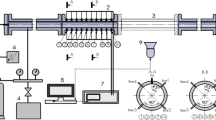Abstract
Results of experimental study on DDT in a smooth tube filled with sensitive mixtures having detonation cell size from 1 to 3 orders of magnitude smaller than the tube diameter are presented. Stoichiometric hydrogen–oxygen mixtures were used in the tests with initial pressure ranging from 0.2 to 8 bar. A dependence of the run-up distance to DDT on the initial pressure is studied. This dependence is found to be close to the inverse proportionality. It is suggested that the flow ahead of the flame results in formation of the turbulent boundary layer. This boundary layer controls the scale of turbulent motions in the flow. A simple model to estimate the maximum scale of the turbulent pulsations (boundary layer thickness) at flame positions along the tube is presented. The largest scale of the turbulent motions at the location of the onset of detonation is shown to be 1 order of magnitude greater than the detonation cell widths, λ, in all the tests. It is suggested that the onset of detonation is triggered during flame acceleration as soon as the maximum scale of the turbulent pulsations increases up to about 10 λ. The model to estimate the maximum size of turbulent motions, δ, and the correlation δ≈ 10λ, give a basis for estimations of the run-up distances to DDT in tubes with internal diameter D > 20λ.
Similar content being viewed by others
References
Urtiew, P., Oppenheim, A.K.: Experimental observations of the transition to detonation in an explosive gas. Proc. R. Soc. Lond. Ser. A 295, 13–28 (1966)
Lee, J.H., Knystautas, R., Chan, C.K.: Turbulent flame propagation in obstacle-filled tubes. In: Proceedings of the 20th Symposium (International) on Combustion, pp. 1663–1672. The Combustion Institute, Pittsburgh, PA (1984)
Peraldi, O., Knystautas, R., Lee, J.H.: Criteria for transition to detonation in tubes. In: Proceedings of the 21st Symposium (International) on Combustion, pp. 1629–1637. The Combustion Institute, Pittsburgh (1986)
Dorofeev, S.B., Kuznetsov, M.S., Alekseev, V.I., Efimenko, A.A., Breitung, W.: Evaluation of limits for effective flame acceleration in hydrogen mixtures. J. Loss Prev. Process. Ind. 14, 583–589 (2001)
Veser, A., Breitung, W., Dorofeev, S.B.: Run-up distances to supersonic flames in obstacle-laden tubes. J. Phys. IV Fr. 12, 333–340 (2002)
Schelkin, K.I.: Occurance of detonation in gases in rough-walled tubes. Soviet J. Tech. Phys. 17(5), 613 (1947)
Soloukhin, R.I.: Deflagration to detonation transition in gases. Soviet Prikladn. Mech. i Techn. Phys. (Appl. Mech. Techn. Phys.) (4), 128 (1961)
Lafitte, P., Dumanois, P.: Compt. Rend. Acad. Sci. Paris 183, 284 (1926)
Lafitte, P.: Influence of temperature on the formation of explosive waves. Compt. Rend. Acad. Sci., Paris 186, 951 (1928)
Egerton, A., Gates, S.F.: Proc. R. Soc. Lond. Ser. A 114, 152 (1927)
Egerton, A., Gates, S.F.: Proc. R. Soc. Lond. Ser. A 116, 516 (1927)
Schelkin, K.I., Sokolik, A.S.: Soviet. Zhurn. Phys. Chem. 10, 479 (1937)
Campbell, G.A., Rutledge, P.V.: Detonation of hydrogen peroxide vapour. Inst. Chem. Eng. Symp. Ser. 33, Institute of Chemical Engineering, p. 37. London (1972)
Bollinger, L.E., Fong, M.C., Edse, R.: Experimental measurements and theoretical analysis of detonation induction distance. Am. Rocket Soc. J. 31, 588 (1961)
Bollinger, L.E., Laughrey, J.A., Edse, R.: Experimental detonation velocities and induction distances in hydrogen–nitrous oxide mixture. Am. Rocket Soc. J. 32, 81 (1962)
Salamandra, G.D., Bazhenova, T.V., Zaicev, S.G., Soloukhin, R.I.: Some methods for investigation of fast-running processes. Acad. Nauk SSSR, Moscow (1963)
Manzhalei, V.I., Mitrofanov, V.V., Subbotin, V.A.: Measurement of inhomogeneities of a detonation front in gas mixtures at elevated pressures. Combust. Explos. Shock Waves (USSR) 10, 89–95 (1974)
Gavrikov, A.I., Efimenko, A.A., Dorofeev, S.B.: Detonation cell size predictions from detailed chemical kinetic calculations. Combust. Flame 120, 19–33 (2000)
Reynolds, W.C.: The Element Potential Method for Chemical Equilibrium Analysis: Implementation in the Interactive Program STANJAN Version 3. Department of Mechanical Engineering, Stanford University, Palo Alto, California (1986)
Gavrikov, A.I., Bezmelnitsyn, A.V., Leliakin, A.L., Dorofeev, S.B.: Extraction of basic flame properties from laminar flame speed calculations. In: Proceedings of the 18th International Colloquium on the Dynamics of Explosions and Reactive Systems, ISBN #0-9711740-0-8, University of Washington, July, 2001, pp. 114/1–114/5 (2001)
Koroll, G.W., Kumar, R.K., Bowles, E.M.: Burning velocities of hydrogen–air mixtures. Combust. Flame 94, 330–340 (1993)
Zel'dovich, Ya.B., Librovich, V.B., Makhviladze, G.M., Sivashinsky, G.I.: On the development of detonation in a non-uniformly preheated gas. Astronautica Acta 15, 313–321 (1970)
Lee, J.H.S., Knystautas, R., Yoshikawa, N.: Photochemical initiation and gaseous detonations. Acta Astronautica 5, 971–972 (1978)
Dorofeev, S.B., Efimenko, A.A., Kochurko, A.S., Chaivanov, B.B.: Evaluation of the hydrogen explosions hazard. Nucl. Eng. Design 148, 305 (1994)
Khokhlov, A.M., Oran, E.S., Wheeler, J.C.: A theory of deflagration-to-detonation transition in unconfined flames. Combust. Flame 108, 503–517 (1997)
Dorofeev, S.B., Sidorov, V.P., Kuznetsov, M.S., Matsukov, I.D., Alekseev, V.I.: Effect of scale on the onset of detonations. Shock Waves 10, 137–149 (2000)
Landau, L.D., Lifshitz, E.M.: Hydrodynamics, 3rd edn., p. 736. Nauka, Moscow (1986)
Loiciansky, L.G.: Mechanics of Fluid and Gas, 5 edn., p. 736. Nauka, Moscow (1978)
Khokhlov, A.M., Oran, E.S., Thomas, G.O.: Numerical simulation of detonation initiation in a flame brush: the role of hot spots. Combust. Flame 119, 400–416 (1999)
Khokhlov, A.M., Gameso, V.N., Oran, E.S.: Effects of boundary layers on shock-flame interactions and DDT. In: Proceedings of the 18th International Colloquium on the Dynamics of Explosions and Reactive Systems, July, 2001, University of Washington, ISBN #0-9711740-0-8 (2001)
Kuznetsov, M., Singh, R.K., Breitung, W., Stern, G., Grune, J., Friedrich, A., Sempert, K., Veser, A.: Evaluation of structural integrity of typical DN15 tubes under detonation loads. Report Forschungszentrum Karlsruhe, December (2003)
Author information
Authors and Affiliations
Corresponding author
Additional information
Communicated by J.E. Shepherd
PACS 47.40.-x; 47.27.Nz
Rights and permissions
About this article
Cite this article
Kuznetsov, M., Alekseev, V., Matsukov, I. et al. DDT in a smooth tube filled with a hydrogen–oxygen mixture. Shock Waves 14, 205–215 (2005). https://doi.org/10.1007/s00193-005-0265-6
Received:
Accepted:
Published:
Issue Date:
DOI: https://doi.org/10.1007/s00193-005-0265-6




